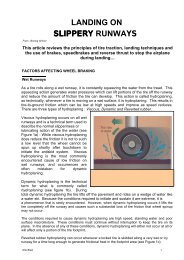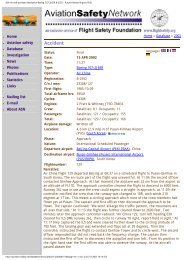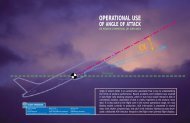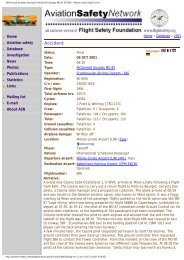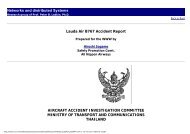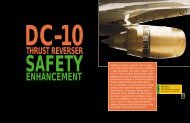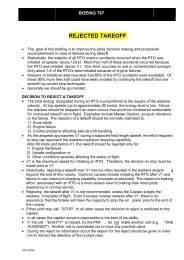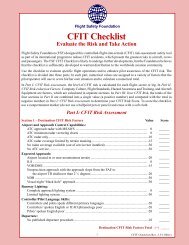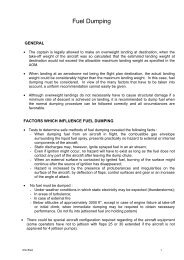Boeing 737-236 series 1, G-BGJL: Main document - Leonardo
Boeing 737-236 series 1, G-BGJL: Main document - Leonardo
Boeing 737-236 series 1, G-BGJL: Main document - Leonardo
Create successful ePaper yourself
Turn your PDF publications into a flip-book with our unique Google optimized e-Paper software.
approximately 42 square inch hole directlyinto the tank interior (Appendix 9). Fragments of this<br />
accesspanel were recovered from the runway and one other fragment ofthe panel was recovered<br />
from inside the tank cavity. Reconstructionof the access panel fragments revealed witness marks<br />
and a patternof distortion which matched exactly the shape of the No 9 combustorcan dome and a<br />
fan case fragment.<br />
Outboard of the engine, the skins forming the tank roof were tornupwards from the spars and the<br />
corresponding bottom skin, formingthe tank floor, was severely bulged downwards. The tank ribs<br />
andinternal structure were distorted in a manner compatible withchordwise tensile loading of the<br />
skins between the spars. Withthe exception of the damaged access panel, all damage to the leftmain<br />
fuel tank was consistent with a rapid overpressure of thetank cavity due to the ignition of fuel<br />
vapour in the outer sectionof the tank. The fracture surfaces at the upper skin/spar interfacewere<br />
relatively clean, whereas the adjoining skin surfaces weresignificantly sooted - indicating that the<br />
explosive overpressureoccurred after the fire had been burning for some time.<br />
At the start of the accident sequence the aircraft fuel load isestimated to have been:-<br />
each wing tank (full) 4,590 kg<br />
centre tank<br />
total<br />
3,420 kg<br />
12,600 kg<br />
The fuel remaining in each tank could not be measured directlybecause of the practical difficulty of<br />
emptying each tank separately.However, a tide mark of soot was found on the internal rib andspar<br />
surfaces inside the left tank at a height which correspondedto the level of the damaged access<br />
panel, enabling the post-accidentfuel contents of the left tank to be determined and hence thetotal<br />
fuel loss to be estimated.<br />
The total quantity of fuel lost from the punctured left wing tankis estimated to have been 2,109 kg<br />
(689 US gals at specific gravity0.808), based on the position of soot 'tide-lines' on verticalsurfaces<br />
wihin the interior of the left wing tank and the tankinitial contents and taxi fuel consumption data.<br />
The leak rate was estimated by the manufacturers, based upon theirknowledge of fuel flow rates<br />
through the various baffles and theinternal structure of the wing. This data suggested that the<br />
leakrate would initially be very high, in the order of 16 US galsper second, but this would decay<br />
rapidly as the tank compartmentimmediately above the puncture emptied. After about 40<br />
seconds,the leak rate would have decayed to approximately 2 US gals persecond and would remain<br />
at approximately that level until approximately200 seconds. Beyond that stage,the rate would taper<br />
off and theflow would cease after a total time of approximately 250 seconds.(Appendix9 )<br />
As an independent check on the validity of the leak rate estimate,the theoretical leak rate was<br />
integrated with time and the resultingtotal compared with the leaked fuel estimate based on the<br />
residualfuel contents. These figures agreed within 5%.<br />
1.12.2.5 Oxygen<br />
The emergency oxygen distribution system mounted in the overheadunits was destroyed in the fire,<br />
but because the system was isolatedthere was no discharge of oxygen. Both passenger and crew<br />
reservoirswere indicating full and the discharge discs were intact.<br />
1.12.2.6 Doors and emergency equipment<br />
Door slides



